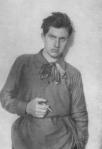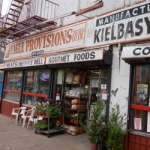Day Seven • 12 Tastes of Brooklyn
 ARTISANAL BREAD MAKING IS NOT FOR SISSIES. The baker’s day starts before the sun rises, and a small batch of handcrafted loaves can take up to three days to make, from start to finish, with repeated fermentation and kneading and rising stages. The natural yeast starter used is a living organism, combining yeast from the air with lactobacteria from the flour and the air to create a fermenting or leavening agent. It’s not called wild yeast for nothing—it can be temperamental, depending on which exact strains of bacteria develop, how they combine with a particular wheat flour, the temperature, and so on. It is the baker’s art to nurture their starter—the mother yeast (madre, if you’re an Italian baker)—like a baby, keeping it alive often for decades, for that is what gives each baker’s breads their distinct flavor and texture.
ARTISANAL BREAD MAKING IS NOT FOR SISSIES. The baker’s day starts before the sun rises, and a small batch of handcrafted loaves can take up to three days to make, from start to finish, with repeated fermentation and kneading and rising stages. The natural yeast starter used is a living organism, combining yeast from the air with lactobacteria from the flour and the air to create a fermenting or leavening agent. It’s not called wild yeast for nothing—it can be temperamental, depending on which exact strains of bacteria develop, how they combine with a particular wheat flour, the temperature, and so on. It is the baker’s art to nurture their starter—the mother yeast (madre, if you’re an Italian baker)—like a baby, keeping it alive often for decades, for that is what gives each baker’s breads their distinct flavor and texture.
This was the way bread was made for centuries—and it’s a craft that is still being practiced in some special places in Brooklyn. So forget that 30-Minute Artisan Bread recipe.
Go instead to Bien Cuit in Boerum Hill or Settepani Bakery in Williamsburg where you’ll be hit by the most intoxicating smells as you walk through the door. Two of our favorite loaves:
MICHE, from Bien Cuit
This is Bien Cuit’s signature bread (pictured, at top) made from three wheat and three rye flours and fermented for up to 68 hours. It’s round and beautiful with a well-done (bien cuit) crunchy crust and very tasty crumb texture. Master baker Zachary Golper learned to bake on an Oregon farm at 19, where he watched and learned from a man who made bread by traditional European methods: building up the starter over a few days and baking the loaves in a wood-fired adobe oven. Golper went on to refine his craft, working in France and at the Bec-Fin in Philadelphia, until, luckily for us, he and his wife, Kate Wheatcroft, opened up a bakery in Boerum Hill. We’ve heard he never sleeps, and we believe it because starting at 7 am, baskets at the bakery are full of fresh bread, including the miche, $10 for a 1 lb loaf.
PANETTONE, from Settepani Bakery
These festive raisin-studded tall round loaves appear in bakeries and groceries around Christmastime, sometimes in beautiful elaborate gift boxes that look good enough to hold the crown jewels. Many are shipped from Italy, where the panettone was invented centuries ago in Milan. (Like all old Italian recipes, there seem to be a lot of tall tales about how it came it be.) But nothing beats a fresh-baked panettone, which is what you’ll find at Settepani Bakery.
Owner Nino Settepani (the name means “seven breads”—how perfect) was born in Sicily, but has lived here most of his life. A master baker trained at the French Culinary Institute, he’s been baking breads and pastries of all kinds for over 30 years now. Production of the panettone begins in the fall each year. The first step is to “wake up” the yeast starter that he uses year after year, refreshing it every day to make it strong and active.
By November 15, he begins making his first batch of panettone, a process that takes up to 30 hours—mixing the dough, proofing it overnight for 12 hours, mixing it again and letting it rise in a temperature-controlled steam box for another 6 or 7 hours. “It might come out at 2 pm, but lately it’s been 4 or 5 pm because it’s so cold,” he tells me. After that the loaves are baked very slowly for two hours. Each holiday season, Settepani Bakery produces more than 600 panettone of various types. The Milanese has raisins and cut dried fruit in it; the Veneziano, almonds, but no raisins. There’s also a chocolate one. They come in 1 lb, 2 lb and “baby” sizes. The Milanese is $16 for 2 lbs, $10 for 1 lb, $2.50 for the baby.
Bien Cuit
120 Smith Street, Boerum Hill
718-852-0200
Settepani Bakery
602 Lorimer Street, Williamsburg
718-349-6524
Photographs by Basia Hellwig. Date stamp typographic design by Joy Makon Design. The font is Gill Sans Ultra Bold, by Eric Gill, Monotype, 1928.






















You must be logged in to post a comment.